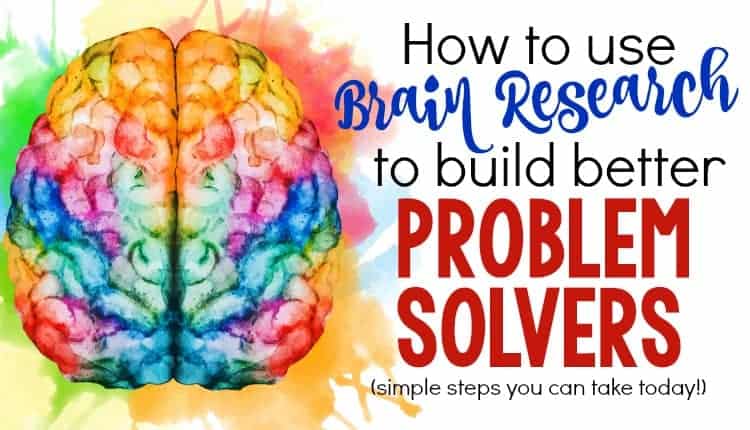Teaching Math Problem Solving: 6 Research-Based Approaches That Work
Whether you’re planning your next math unit or prepping for state testing, word problems always find a way into the conversation. And teaching kids to solve them—without resorting to stacks of worksheets filled with boring story problems—is no small task.

Today’s word problems aren’t the simple one-step questions we remember. They’re multi-step, concept-packed challenges that show up in everyday lessons and big tests alike.
The good news? Brain research offers simple, effective strategies that make teaching problem solving easier—even for reluctant or struggling learners.
What research says about building master problem solvers in math
Have you seen how many math skills we’re expected to teach these days? It feels impossible to build deep understanding and teach step-by-step math problem solving effectively… or is it?
Research suggests we may be approaching it all wrong. While there are many reasons students struggle with word problems, one major culprit is that we’re not aligning our instruction with how the brain learns best.
Here’s what brain research says are the essential elements for building real step-by-step math problem-solving skills—especially for learners who need extra support.
Finding #1: Mastery Requires Repetition
Duh, right? We all know kids need practice to get better at math word problems. But what kind of practice works best—and how much is enough?
Let’s start with the idea of mastery.
Back in the 1990s, Anders Ericsson studied what made experts excel. His research showed that deliberate practice—focused effort that requires concentration (and isn’t always fun)—was the key to skill development. This became the foundation for Malcolm Gladwell’s famous “10,000-hour rule.”
But here’s the real question: for students who struggle with word problems, what does that practice look like? Is it better to do deep dives or stick with short, consistent bursts?
Designing Better Word Problem Activities: Building Step-by-Step Math Problem-Solving Practice
To figure out the best way to structure practice, let’s turn to Ebbinghaus’ work on memory and retention. He found that spacing practice over time actually reduces the total amount of practice needed. In other words: a little bit, spread out, works better than cramming.
And this isn’t new. For more than 80 years, research has shown that while mass practice (a big chunk of practice all at once) might help students perform better on tomorrow’s quiz, it doesn’t stick. Repeated, spaced-out practice leads to stronger long-term retention (Bloom & Shuell, 1981; Rea & Modigliani, 1985).
So how much review time does the research recommend?

How Long Should Problem-Solving Practice Really Be?
Shorter is better.
Deliberate practice takes focus—and research shows our brains can only stay in that high-focus zone for so long. Most studies point to 8–10 minutes as the ideal window for meaningful learning (Robertson, 2010).
That means your problem-solving time should be intentional. Use those minutes to break down a word problem, model step-by-step math problem solving strategies, and guide students through the thinking process—not just the answer.
Teacher Tip: Applying This in Your Classroom (or Homeschool!)
Less really is more—as long as you’re consistent. Students who struggle with word problems benefit most from regular, bite-sized practice sessions. Keep whole-group discussions to 8–10 minutes max, and focus on depth over quantity.
Try this:
- Set aside 8–12 minutes daily just for problem solving—treat this time as sacred.
- Use 1–2 word problems per day. Keep it focused, and guide students through step-by-step math problem-solving with a “less is more” approach.
- Try a Problem of the Day format to build stamina and skills over time without overwhelm.
Finding #2: Students Who Are Challenged and Supported See Better Outcomes
Research calls it productive struggle—the kind of effortful practice that builds real, lasting understanding.
For students to thrive in this zone, they need opportunities for choice, collaboration, and materials that spark their interest (more on that later!). This process helps them build flexible thinking—so they can apply what they’ve learned to new or unfamiliar problems (Bransford, Brown, & Cocking, 2000).
“Meaningful learning tasks need to challenge every student in some way. It is crucial that no student be able to coast to success time after time; this experience can create the belief that you are smart only if you can succeed without effort.”
— Carol Dweck
Of course, challenge without support leads to frustration. Timely feedback and encouragement are essential—especially when students hit a tough spot or feel like their goal is out of reach (Cimpian, Arce, Markman, & Dweck, 2007).
Simple Ways to Build Productive Struggle into Your Math Routine
Students who struggle with word problems need opportunities to wrestle with them—but in a way that builds confidence, not tears it down. When challenges are reasonable and paired with support, students gain both skills and self-belief.
Here are a few easy ways to bring productive struggle into your math time:
- Choose problems that sit just outside their comfort zone. Aim for the sweet spot in their Zone of Proximal Development—challenging, but achievable with effort.
- Model or scaffold tougher problems. Show students how to take risks by thinking aloud, breaking things into steps, and encouraging strategy talk.
- Provide daily feedback and support. Review work together, talk through approaches, and normalize mistakes as part of the process.
Finding #3: Novelty & Variation Are Keys to Engagement
In both standardized testing and real life, problems don’t come with a label telling students which strategy to use. That’s why it’s so important to build in mixed practice—opportunities where students have to stop, think, and ask themselves: What is this problem asking? What strategy fits best?
This kind of variation strengthens metacognitive skills and keeps students engaged on a deeper level (Rohrer & Taylor, 2014). It shifts the focus from just solving to truly thinking through the problem.
Why Novelty Matters
A 2013 study found that when students practiced already-familiar skills in new ways, it helped:
- Reduce errors caused by distraction or boredom
- Improve sustained attention
- Boost motivation and engagement
In other words, adding a little novelty makes review more effective.
Use Variety to Deepen Understanding
For students who struggle with word problems, novelty is more than just a hook—it’s a path to deeper understanding. When they have to apply familiar strategies to new formats or problem types, they begin to see patterns, analyze structure, and build real confidence.
Compare that to a worksheet full of same-skill story problems, where students can often solve by rote without truly engaging. Mixing it up makes them think—and thinking leads to learning.
Try This: Add Novelty & Variation to Word Problem Practice
Don’t be afraid to shake things up! Here are a few simple ways to add variety and boost engagement:
- Mix the skills. Word problems don’t have to match that day’s math lesson—throw in a review skill or two.
- Switch up the format. Use different structures, problem types, or question styles to build flexibility.
- Vary the wording or theme. Same skill, new context. This helps students generalize what they’ve learned.
Finding #4: Interest & Emotion Boost Retention and Skill Development
We’ve all seen it: the magic of a lesson that sticks. When students are emotionally engaged or truly interested, they remember what they learned—and they want to learn more.
But what does the research say?
The Science Behind Emotion & Learning
Neuroscientists have found that emotion creates stronger connections in the brain, supporting long-term retention and deeper understanding (Immordino-Yang, 2016). That means if you can link a word problem to a meaningful scenario or emotion, students are more likely to internalize the skill.
Whether it’s solving a real-world problem or sharing a surprising fact that makes them go whoa!, emotion can be a powerful teaching tool.
Why Student Interests Matter
Decades of research also confirm that tying learning to student interests improves outcomes and motivation—especially for kids who struggle with word problems (Chen, 2001; Chen & Ennis, 2004; Solomon, 1996). It’s not just about Pokémon obsessions, either.
“Interest” can mean:
- Letting social students work in pairs or small groups
- Using hands-on tools or manipulatives
- Giving students the freedom to be themselves while building essential skills
The more personally relevant the task, the more likely students are to stay engaged and push through challenges.
What This Looks Like in a Math Class
Use interest and emotion to hook the brain and make problem-solving stick—even for learners who usually disengage with word problems.
Here’s how to start applying this:
- Choose word problems that match student interests—sports, animals, space, baking… anything goes!
- Connect math to real-life emotions or situations—joy, surprise, frustration, curiosity.
- Try a weekly theme to tie problems together and keep kids curious about what’s coming next.
Finding #5: Student Autonomy Builds Confidence & Independence
Autonomy is all about students feeling in control of their learning—choosing how they engage with tasks and demonstrate what they know.
Why Autonomy Matters
Research shows that when students feel a sense of ownership, they’re more engaged, more independent, and more motivated to learn (Reeve, Nix, & Hamm, 2003).
Of course, that doesn’t mean tossing them into the deep end. Students—especially those who struggle—still need modeling, support, and guidance. But even small opportunities for choice and control can make a big difference (Wielenga-Meijer et al., 2011).
Supporting Autonomy (Even for Kids Who Struggle to Stay on Task)
Here’s what the research says works:
- Explain the why. If a strategy feels like “extra work,” take time to explain why it’s a valuable option.
- Acknowledge the hard stuff. When kids are frustrated, don’t brush it off. Sometimes the barrier isn’t the skill—it’s the emotion tied to the struggle.
- Offer real choices. For students who find word problems overwhelming, let them pick:
- Work solo or with a partner
- Try a different strategy
- Skip and return to a tricky problem later
When students feel they have some say, they’re more likely to stick with the challenge—and grow because of it.
Fostering Autonomy in Your Math Class
You’re not going to hold their hands forever—and that’s a good thing. Building autonomy now helps students become confident, capable learners down the road (McCombs, 2002, 2006).
Try these simple steps:
- Give students quiet time to solve independently (or with a buddy).
- Encourage multiple strategies. There’s more than one “right” way.
- Support without rescuing. Read the problem aloud, offer encouragement, but let them do the thinking.
Autonomy is powerful. And for many students, especially those who struggle with word problems, it’s the key to unlocking not just skills—but self-belief.
Finding #6: Students Need to Learn How to Fail—and Recover From It
We know that practice matters—but so does talent. Brooke Macnamara’s 2014 analysis of 88 studies found that while deliberate practice is key, students still need different amounts of practice to reach mastery.
So how do we support those who struggle with word problems without letting them fall behind—or give up?
The Power of “Yet”
Growth mindset research gives us a roadmap. Teaching students to embrace the word yet—as in, I can’t solve this… yet—helps normalize failure as part of learning.
This mindset opens the door to multiple practice opportunities, peer collaboration, and the kind of persistence that builds real math problem-solving skills.
When Advanced Students Hit a Wall
Students who typically succeed without much effort may meet their match with complex word problems. When they do, they need high expectations, honest feedback, and—most importantly—a chance to revise and try again.
But our grading system doesn’t always make room for that.
Building the Confidence to Fail (and Try Again)
Students often feel pressure to get the right answer on the first try. But when we create a safe space to fail, reflect, and revise, they grow more than they would from instant success.
Try these strategies to build resilience and confidence:
- Make space for error analysis and reflection.
- Celebrate effort and growth—not just accuracy.
- Hold off on grading early attempts so students aren’t afraid to be wrong.
When students believe that mistakes are part of the journey, they stop avoiding hard problems—and start learning from them.
Getting Started with Brain-Based Problem Solving
The research is clear: spending 45 minutes slogging through same-old story problems isn’t the path to mastery. But with a brain-based approach, you can build real math problem-solving skills—without the burnout (for you or your students).
If you’re ready to ditch the overwhelm and bring consistency, strategy, and engagement to your routine, I’ve got something to help.
My Problem of the Day bundles are designed with this research in mind—short, intentional practice sessions that build confidence, flexibility, and step-by-step thinking over time.
You can grab them month-by-month or save big with the full-year bundle. They’re available for Grades 1-8.
Want to try it first?
You can grab a free sample and start helping your learners build real math problem-solving skills—without the stress.







